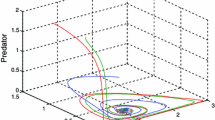Abstract
A predator-prey model, where both species are subjected to parasitism, is developed and analyzed. For the case where there is coexistence of the predator with the uninfected prey, an epidemic threshold theorem is proved. It is shown that in the case where the uninfected predator cannot survive only on uninfected prey, the parasitization could lead to persistence of the predator provided a certain threshold of transmission is surpassed.
Similar content being viewed by others
References
Anderson, R. M., May, R. M.: The invasion, persistence, and spread of infectious diseases within animal and plant communities. Philos. Trans. R. Soc. Lond., B 314, 533–570 (1986)
Aron, J. L., May, R. M.: The population dynamics of malaria. In: Anderson, R. M. (ed.) The population dynamics of infectious diseases, theory and application, pp. 139–179. London: Chapman and Hall 1982
Arendt, W., Grabosch, A., Greiner, G., Groh, U., Lotz, H. P., Moustakas, U., Nagel, R., Neubrander, F., Schlotterbeck, U.: One-parameter semigroups of positive operators. (Lect. Notes Math., vol. 1184) Berlin Heidelberg New York: Springer 1986
Butler, G. J., Freedman, H. I., Waltman, P.: Uniformly persistent systems. Proc. Am. Math. Soc. 96, 425–430 (1986)
Curio, E.: Behavior and parasitism, chap. 2. In: Mehlhom, K. (ed.) Parasitology in focus, pp. 149–160. Berlin Heidelberg New York: Springer 1988
Dietz, K.: The incidence of infectious diseases under the influence of seasonal fluctuations. (Lect. Notes Biomath., vol. 11, pp. 1–14) Berlin Heidelberg New York: Springer 1976
Dobson, A. P.: The population biology of parasite-induced changes in host behavior. Q. Rev. Biol. 63, 139–165 (1988)
Freedman, H. I.: Graphical stability, enrichment, and pest control by a natural enemy. Math. Biosci. 31, 207–225 (1976)
Freedman, H. I.: Deterministic mathematical models in population ecology. HFR Consulting Ltd.: Edmonton, 1987
Freedman, H. I., Waltman, P.: Persistence in models of three interacting predator-prey populations. Math. Biosci. 68, 213–231 (1984)
Freedman, H. I., Waltman, P.: Persistence in a model of three competitive populations. Math. Biosci. 73, 89–101 (1985)
Freedman, H. I., Wolkowicz, G. S. K.: Predator-prey systems with group defense: the paradox of enrichment revisited. Bull. Math. Biol. 48, 493–508 (1986)
Gantmacher, F. R.: The theory of matrices, Chap. 13. Chelsea 1959
Hadeler, K. P., Dietz, K.: Nonlinear hyperbolic partial differential equations for the dynamics of parasite populations. Comput. Math. Appl. 9, 415–430 (1983)
Hadeler, K. P.: Spread and age structure in epidemic models. In: Perspectives in Mathematics, Anniversary of Oberwolfach. Basel: Birkhäuser 1984
Hadeler, K. P., Dietz, K.: Population dynamics of killing parasites which reproduce in the host. J. Math. Biol. 21, 45–65 (1984)
Hofbauer, J., Sigmund, K.: Permanence for replicator equations. In: Kurzhansky, A. B., Sigmund, K.: Dynamical systems. (Lect. Notes. Econ. Math. Syst., vol. 287) Berlin Heidelberg New York: Springer 1987
Holling, C. S.: Some characteristics of simple types of predation and parasitism, Can. Ent. 91, 385–398 (1959)
Holmes, J. C., Bethel, W. M.: Modification of intermediate host behaviour by parasites. In: Canning, E. V., Wright, C. A. (eds.) Behavioural aspects of parasite transmission. Suppl. I to Zool. f. Linnean Soc. 51, 123–149 (1972)
Kermack, W. O., McKendrick, A. G.: A contribution to the mathematical theory of epidemics. Proc. R. Soc. Lond., A 115, 700–721 (1927)
Kuang, Y., Freedman, H. I.: Uniqueness of limit cycles in Gause-type models of predator-prey systems. Math. Biosci. 88, 67–84 (1988)
Kretzschmar, M.: A renewal equation with birth-death process as a model for parasitic infections. J. Math. Biol. 27, 191–221 (1989)
Liu, L. P., Cheng, K. S.: Global stability of a predator-prey system. J. Math. Biol. 26, 65–71 (1988)
MacDonald, G.: The analysis of equilibrium in malaria. Tropical Diseases Bulletin 49, 813–828 (1952)
MacDonald, G.: The measurement of malaria transmission. Proc R. Soc. Medic. 48, 295–301 (1955)
Bruce-Chwatt, L. J., Glanville, V. J. (eds.) Dynamics of tropical disease. Selected papers by G. Macdonald. Oxford: Oxford University Press 1973
Mech, L. D., McRoberts, R. E., Peterson, R. O., Page, R. E.: Relationship of deer and moose populations to previous winter's snow. J. Anim. Ecol. 56, 615–627 (1987)
Peterson, R. O., Page, R. E.: Wolf density as a predictor of predation rate. Swedish Wildlife Research Suppl. 1, 771–773 (1987)
Peterson, R. O., Page R. E.: The rise and fall of isle Royale wolves, 1975–1986. J. Mamm. 69(I), 89–99 (1988)
Rosenzweig, M. L.: Paradox of enrichment: Destabilization of exploitation ecosystems in ecological time. Science 171, 385–387 (1971)
Waldstätter, R., Hadeler, K. P., Greiner G.: A Lotka-McKendrick model for a population structured by the level of parasitic infection. SIAM J. Math. Anal. 19, 1108–1118 (1988)
Waltman, P.: Deterministic threshold models in the theory of epidemics. (Lect. Notes Biomath. vol. 1) Berlin Heidelberg New York: Springer 1974
Author information
Authors and Affiliations
Additional information
Support by the Central Research Fund of the University of Alberta is gratefully acknowledged
Research partially supported by the Natural Sciences and Engineering Research Council of Canada, Grant No. NSERC A4823
Rights and permissions
About this article
Cite this article
Hadeler, K.P., Freedman, H.I. Predator-prey populations with parasitic infection. J. Math. Biology 27, 609–631 (1989). https://doi.org/10.1007/BF00276947
Received:
Revised:
Issue Date:
DOI: https://doi.org/10.1007/BF00276947




